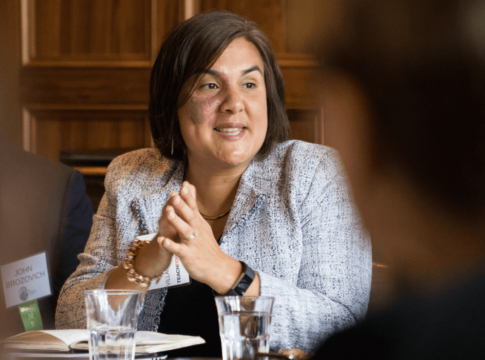Within days of taking on their new roles as co-chief executives of Teach For America (TFA), Elisa Villanueva Beard and Matt Kramer planned to take off on a 100-day tour of the 46 cities and rural areas where TFA works, “leaving our agenda behind,” Kramer said. “I expect it will lead to changes in things,” he told me.
 The project that Wendy Kopp launched with a 1989 college thesis placed 10,400 teachers in 2012, with plans to expand to 15,000 teachers and 60 sites by 2015. To hit that target, Beard told me, TFA will need revenues of a half billion dollars a year, up from $320 million in 2012. Overseas, entrepreneurs in 26 countries have launched TFA projects under a sister organization called Teach For All; projects in another 18 countries are in the pipeline.
The project that Wendy Kopp launched with a 1989 college thesis placed 10,400 teachers in 2012, with plans to expand to 15,000 teachers and 60 sites by 2015. To hit that target, Beard told me, TFA will need revenues of a half billion dollars a year, up from $320 million in 2012. Overseas, entrepreneurs in 26 countries have launched TFA projects under a sister organization called Teach For All; projects in another 18 countries are in the pipeline.
And more changes are ahead?
Kramer, previously TFA’s president, portrays the leadership shift as little more than a change in business cards, formalizing Kopp’s evolution out of TFA’s day-to-day activities and reassigning some of her public duties to himself and Beard, who previously was chief operating officer. The new arrangement puts Kramer in charge of recruiting, training, fundraising, marketing, and administration, while Beard will run the regional operations and become TFA’s public face.
Kopp becomes TFA’s board chair and remains chief executive of Teach For All.
Kramer sees TFA as, yes, a pipeline of teachers into poor and neglected neighborhoods. Its teachers were in 3,200 public schools in 2013 (nationwide, two-thirds of those were district schools), and 57,000 college students applied to become corps members. But Kramer also paints a vision of TFA as an instigator of change, producing alumni that TFA expects—just expects—will become the sort of shake-up-the-beast leaders who will “do something radically different” for the schools.
The beast shaking seems well under way. TFA says 550 alumni are school principals, 100 are system leaders, and 70 hold elective office. Charter operators, education entrepreneurs, and philanthropists increasingly follow TFA into its new neighborhoods, “magnetizing talent,” Kopp calls it. (Indeed, several education entrepreneurs told me they wouldn’t expand their projects into cities where there isn’t a TFA presence because they couldn’t be sure of attracting the talent they need.)
A study by Harvard professor Monica Higgins and co-authors Wendy Robison, Jennie Weiner, and Frederick Hess (“Creating a Corps of Change Agents,” features, Summer 2011) found that of the 49 leading entrepreneurial organizations in education, 14 had at least one top manager who was a TFA alumnus. And Weiner contends that TFA alumni are driving the curriculum at education schools. “They come here wanting to know more about solutions” like charters, school choice, and teacher evaluation, she said. “The [TFA] commitment may end after two years, but there’s a forward momentum” that goes on and on.
I wondered how TFA has managed to keep that forward momentum after almost 24 years. After all, there are plenty of start-ups—in education and everywhere else—that have been slowed by middle-aged paunch. There probably are a lot of reasons, researchers, funders, and TFA’s fellow entrepreneurs told me, but here are four:
Common Vision, Regional Innovation
Josh Anderson is the executive director of the Chicago Teach For America project, which has 500 corps members dispersed in 187 schools and a staff of 64 to support them. Like all TFA executive directors, Anderson must raise his entire operating budget (the schools pay the corps members’ salaries), which is $12.8 million this year. The state and city put up $2.2 million of that, but the biggest share, almost $7 million, comes from individual donors and family foundations.
The Chicago project’s growth is on pace to meet its 2015 goals, he told me, so he has begun setting 2017 targets: 1,000 corps members and a budget “north of $20 million.” Like other executive directors, Anderson also sets his region’s education agenda, and among his plans is an “inspire zone” in seven contiguous neighborhoods. The idea is to concentrate corps teachers in the zone, install corps alumni as principals, and invite in high-performing charter networks to help leverage the impact.
Anderson, who is 31 and a former New York corps member, said it’s “the expectation” that executive directors develop and fund their own plans. “The ideas and vision for what needs to happen in Chicago emanates from Chicago,” he added.
Kopp has written about TFA’s earliest days, when everyone had a vote in every decision, and strategy sessions lasted much of the night. It began abandoning that folly about five years in, she says. Now, half of TFA’s 1,900 staffers are in the regions where TFA is teaching and 80 percent of its revenue comes from fundraising by the regional projects. Executive directors were told to start asking “what it’s going to take for every kid to get an excellent education” in their region, and then go out and do it, Kramer said.
That keeps TFA regions innovative and learning from one another, Jane Hannaway, director of the National Center for Analysis of Longitudinal Data in Education Research, told me. But what keeps it from spinning off into 46 disconnected projects? I asked.
One explanation is a communications network that seems to hum with activity. There are thrice-yearly conferences where executive directors “problem solve” and “transfer knowledge,” Anderson said. There are phone briefings, a newsletter, conference calls, seminars, and an ongoing review of the “negotiables” and the “flexibles” in the TFA model, Elisa Beard said. “We don’t want it to feel like they’re entirely different organizations when we go from one region to another.”
Perhaps the bigger reason, though, is what Alex Hernandez, a partner in the Charter School Growth Fund, called “a superclear mission.” TFA has a concise manifesto that commits it to eliminating educational inequity. That vision is so central to TFA’s culture that it’s “imprinted” on corps members as a set of shared understandings, said Harvard’s Higgins.
“We’re working toward the same thing,” James Curran, the executive director in South Dakota, told me. “We’re just doing it in different ways.”
Data-Driven Improvement
Katie Jaron is TFA’s vice president for leadership development, a job in which she thinks about what would make corps members more effective teachers. In 2011, she asked a large consulting firm to study some school districts and charter management organizations that were known for giving robust support to their teachers.
TFA already provides a coach, called a manager of teacher leadership and development, to every corps member (TFA says 89 percent of its first-year corps members return for a second year, and 63 percent go into education as a career). But the consultants, and internal surveys, told Jaron that there were gaps in TFA’s coaching. So this year Jaron, who is 33 and a Houston corps alumna, launched a pilot project that adds content and classroom-management coaches in Houston and several other cities.
The content coaches offer technical advice on how to teach elementary grades, math and science, and the humanities. The management coaches are each equipped with a walkie-talkie and coach a corps member—who is equipped with an earpiece—through classroom behavior problems as they’re happening.
There’s more: in Jacksonville, executive director Crystal Rountree is piloting a summer training institute for 100 new corps members who will teach in Duval County schools next fall. Typically, TFA assigns its new teachers to one of nine summer training institutes that are spread around the country. Rountree, who is 31 and a former corps member in Atlanta, said that under that system, her new teachers would arrive in Jacksonville with limited understanding of the city and its schools.
So last year, she brought together Duval’s superintendent and board of education, the president of a local university, and others, and said, “Let’s do some thinking about what it would look like” to train TFA teachers locally. The teachers will arrive in their schools weeks earlier; they’ll supplement the district’s summer-school program and they’ll know their students even before school starts. Rountree already is planning weekly dinners for the new teachers with parents, veteran teachers, and city officials.
Still more: in South Dakota, Curran, who is 29 and a former Phoenix corps member, is part of a seven-region pilot project to build an incubator to prepare teachers in rural districts to become principals. It’s being funded with a competitive TFA “innovation grant” that the executive directors collectively applied for out of frustration that there was no infrastructure to develop principals for their schools.
The pilots—there are loads more—and other programmatic decisions “aren’t just hunches,” said Jane Hannaway, whose daughter is a TFA alumna. TFA is “constantly trying to figure out better ways to do things,” she added. (In addition to its internal research, TFA has a five-person team that cooperates with researchers on “dozens” of studies of TFA’s effectiveness and is looking for more, said Raegen Miller, TFA’s vice president for research partnerships.)
Even more compellingly, when the data show that something isn’t working—“and they’re always monitoring—they have the money and wherewithal to scrap it and redesign it,” said Susan Moore Johnson of Harvard’s Graduate School of Education. (Her daughter also is a TFA alumna.)
Based on all that scrutiny, TFA cut the number of corps members that each teaching coach supervises to 30 or fewer, down from 50 a few years ago (in Chicago, Anderson cut it further, to 20 teachers per coach). Corps members now teach “life skills,” like persistence and problem solving, and “access skills,” like note taking and skim reading, that will help students get into college.
“We are one of the most data-driven, matrix-driven organizations I know,” Annis Stubbs, the executive director of the Detroit TFA project told me.
Global Reach
Amy Black is vice president of development for Teach For All, which Kopp co-founded in 2007 after pleas from entrepreneurs in Britain—and then Germany, India, Lithuania, China, Lebanon, the Philippines—to help set up projects in their countries. Black said TFA concluded that the challenges were the same in every country—poor kids don’t have the same access to education as richer kids—and that TFA could “help shorten the learning curve” for those entrepreneurs.
TFA requires the international projects to place teachers in full-time jobs for two years, measure student performance, and be independent of their governments, among other things. But how, what, and whom they teach “are questions every program is answering,” Black said.
That experimentation will accelerate innovation (talk about crowd sourcing!), Harvard’s Monica Higgins and other researchers told me. The overseas projects will force TFA to examine its assumptions about how kids learn, teachers are trained, school systems are set up and funded, and more. “Nothing else is going to push them as much,” Higgins said.
Beyond that, exposure to different cultures will keep TFA “open to new ways of doing things,” which can be a challenge for young companies, Jon Schnur, a co-founder of two education nonprofits, America Achieves and New Leaders for New Schools, told me. “It will keep them learning from educators around the world.”
TFA already is taking lessons in “values leadership” from Teach For India, Black and Kopp both told me—that is, how to instill teachers with a sense of mission and urgency. It’s also watching how the projects in India and Israel recruit teachers, should it decide to expand its own recruiting outside college campuses. Both countries recruit older corps members—Israel because college graduates first must serve in the military, and India because it’s looking for corps members who are mature enough to move into jobs as principals as soon as their teaching commitment is up.
“There’s a ton of leadership literature out there, but the newest, freshest information we’re getting” is from Teach For India, Black said.
Stoking the Leadership Fire
Two years ago, in its annual alumni survey, TFA asked its 28,000 former corps members if they were interested in becoming superintendents or in taking other district-level posts. There was “overwhelming interest,” Andrea Stouder Pursley, vice president of alumni affairs and a former corps teacher in Phoenix, told me. But that interest didn’t correlate with the number of alumni who actually went into district leadership.
So Pursley enlisted another management consultant to figure out why and, beyond that, what kind of skills and preparation a successful superintendent needs. From there, TFA built a part-academic, part-on-the-job fellowship program that will place alumni in district offices for a year beginning this fall. Some 160 alumni applied for 20 spots; 25 districts asked for fellows.
Among the other molds TFA has broken, it has “reframed the way to think about alumni relations,” said Jennie Weiner, a postdoctoral fellow at the Harvard Graduate School of Education. Most organizations look to their alumni for what they can give back; TFA looks to its alumni to carry its mission forward.
Kopp says it was TFA’s vision from the start to get its alumni into jobs where they could influence—no, direct—education policy. “We’re not going to solve this problem in the classroom. We want [alumni] out there, pioneering new things we never thought of,” she told me.
That squares with a complaint I heard from Harvard’s Susan Moore Johnson, that TFA’s two-year commitment “isn’t designed to increase the capacity of a school over time.” Corps members come and go, but the school remains woefully the same (indeed, part of the reason for those life-skills and persistence lessons corps members now teach is to help students cope with a weak teacher they may be assigned the next year, or the year after that).
Getting TFA alumni into leadership roles, though, has meant first creating an enormous talent-building infrastructure of graduate-school partnerships, employer internships, an in-house career-counseling center, and an organization to help alumni win elected office. Almost one in 10 TFA staffers now works on alumni development, including a three-person “entrepreneurship team” that helps alumni with their education start-ups and hosts an annual “design camp” for innovators. Last year, 150 showed up to compete for $150,000 in start-up capital. (The big winner: GirlTrek, which encourages African American girls and women to lose weight through walking.)
TFA sets annual goals for the number of alumni it expects to become principals, school-board members, state school chiefs, even congressmen. Kopp wouldn’t share the goals, but told me they “seem like the right intersection between stretch and realism.” An early alumni survey showed that 5 percent of former corps members who were still in education were principals, so Kopp said she figured that 10 percent could make the jump if TFA provided some counseling and support. Within a few years, she said, 12 percent had.
Pushing the Limits
When I asked Elisa Beard, the new co-CEO, what was the greatest constraint on TFA’s growth plans, “leadership capacity” was at the top of her list, a surprise because of TFA’s focus on leadership development. But in early 2013, four TFA regions lacked executive directors, and Beard scrapped plans to open in two new cities in the fall because she hasn’t found qualified executive directors. Her solution is to launch—what else?—a pilot project to develop executive directors.
Kopp also named talent recruitment as “a big potential limitation,” but she meant teacher talent. For all the campus excitement TFA seems to generate, recruiting is a challenge, she said. TFA says that of the 48,000 people who applied in 2012, it accepted only 17 percent, about 8,200, and of those, just 5,800 took up its offer.
TFA’s costs average $40,000 per corps member over three years, including recruiting, pre-service training, in-service coaching, and overheads, and those costs haven’t come down even as TFA has grown. In part, that’s because “there are new ideas every day for things we need to do,” Kopp said (think of those design camps, the summer institute, the coaches). And in part, it’s because some expenses—Kramer named labor law, finance, accounting—don’t lend themselves to scale-up savings, he said. “What it takes to do things right at a bigger scale is more than it costs to do them right at a tiny scale,” he said. “It’s not at the top of my thinking that we have to slash,” he added.
TFA also claims favorable comparisons with other service organizations: it says the Peace Corps spends $78,000 to recruit, train, and support a volunteer for a two-year commitment (the National Peace Corps Association puts the cost at $50,000 a year). VISTA asks localities to pony up $11,000 a year for a community-service volunteer, to which it adds $12,000 in benefits.
Almost three-quarters of TFA’s revenues came from philanthropy in 2011—$194 million, up $40 million from the year before, according to the latest annual report—and Kopp said “it’s actually been powerful” to have to appeal to donors. “It’s forced us to get out in the world and sell this cause.” Funders encourage innovation by asking for results: they’d take their money somewhere else if they lost confidence. Just as important, they become what Kopp called “champions” of education reform.
Those champions no doubt will be watching Kramer and Beard—and those half-billion-dollar plans. I asked Kramer what he worried about as the co-CEO. “Whether or not we fulfill our potential,” he told me without a moment’s pause.
June Kronholz is an Education Next contributing editor and a former Wall Street Journal education reporter, foreign correspondent, and editor.
This article appeared in the Summer 2013 issue of Education Next. Suggested citation format:
Kronholz, J. (2013). Still Teaching for America: Common vision creates forward momentum. Education Next, 13(3), 38-43.





